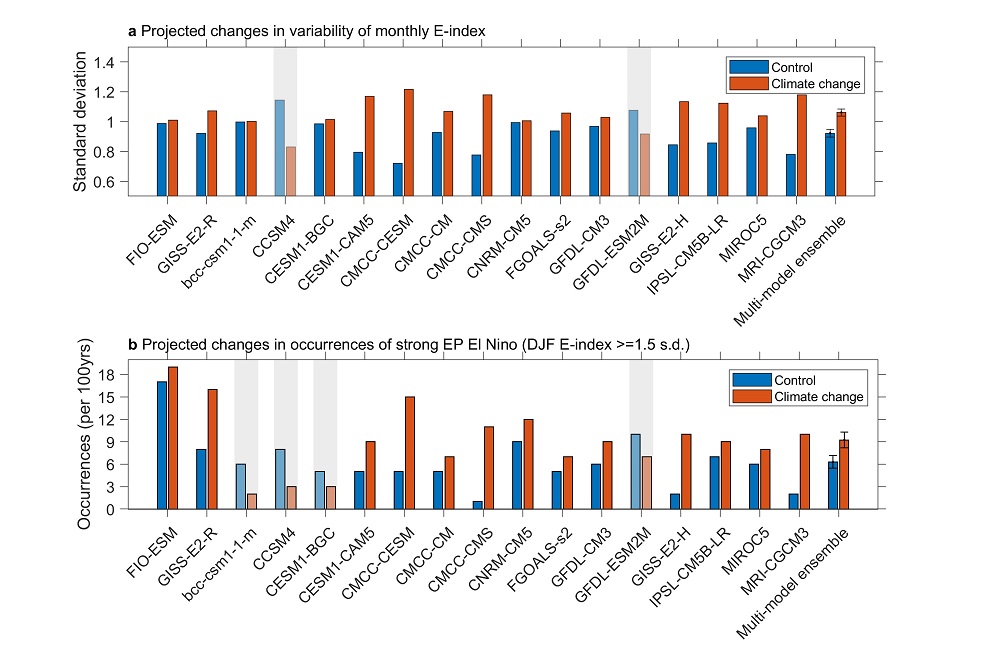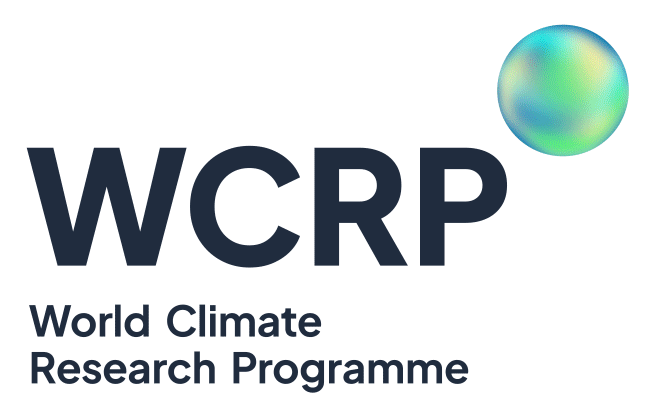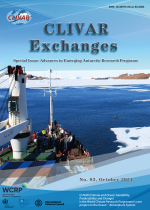Eastern Pacific El Niño is projected to intensify under global warming

Figure: a, Comparison of the standard deviation of the E-index over the present-day (1900–1999) and future (2000–2099) 100-year periods in the 17 selected models. 15 of the 17 selected models (88%) simulate a greater variance in the E-index in the future period (red bars) than in the present-day period (blue bars); the two models that simulate a reduction in variance are greyed out. b, Number of strong EP-El Niño events (E-index > 1.5 s.d.) that occurred in the two 100-year periods. The multi-model mean is also shown in a and b; error bars in the multi-model mean correspond to the 95% confidence interval. The differences between the present-day and future multi-model-mean E-index (s.d.) and between the present-day and future multi-model-mean number of strong events are statistically significant at more than the 95% confidence level. The increase in EP-ENSO SST variance (E-index variance) generally translates to more EP-El Niño events for a given E-index intensity.
The eastern Pacific El Niño will intensify under a scenario of high emission of carbon dioxide. The breakthrough is reported in a Nature article, on 12th December 2018 (see https://www.nature.com/articles/s41586-018-0776-9, and a News & Views piece https://www.nature.com/articles/d41586-018-07638-w), accompanied by a Research Highlight (see https://www.natureasia.com/en/research/highlight/12814). The finding, which represents a milestone, according to the News and Views, implies that more frequent extreme weather events are likely going to happen in the future.
The El Niño-Southern Oscillation (ENSO) is the most consequential climate phenomenon on Earth; the eastern Pacific El Niño is associated with flooding in eastern Pacific regions and droughts in western Pacific regions. However, a lack of inter-model consensus regarding the response of eastern Pacific sea surface temperatures - a crucial diagnostic for the eastern Pacific El Niño - means that the effect of global warming on the ENSO remains uncertain for decades. Conventionally, the response of El Niño SST variability to global warming has been investigated in climate models using SSTs at a fixed location (Niño3 region as EP-El Niño centre).
Wenju Cai, new co-chair of CLIVAR Scientific Steering Group, and colleagues studied 17 climate models from the Coupled Model Intercomparison Project Phase 5 (CMIP5) to assess changes in the eastern Pacific El Niño under future global warming. By tracking the anomaly centre of each model (the location of the most extreme temperature change), the authors report that almost all models (88%) predict an increase in sea surface temperature variability at their respective anomaly centre. This corresponds to an overall mean increase of 15% in eastern Pacific El Niño sea surface temperatures variability between present-day (1900-1999) and predicted future (2000-2099) climates.
Such an increase in sea surface temperature variance implies an increase in the number of ‘strong’ eastern Pacific El Niño events (corresponding to large sea surface temperature anomalies), and the authors conclude that we should expect more extreme weather events in the future as a result.
(Summary prepared by Guojian Wang, CSIRO)
********************************************************************
- Cai, W., Wang, G., Dewitte, B., Wu, L., Santoso, A., Takahashi., K., Yang, Y., Carreric, A. and McPhaden, M. J. Increased variability of eastern Pacific El Nino under greenhouse warming. Nature 564, 201-206 (2018).














Add new comment